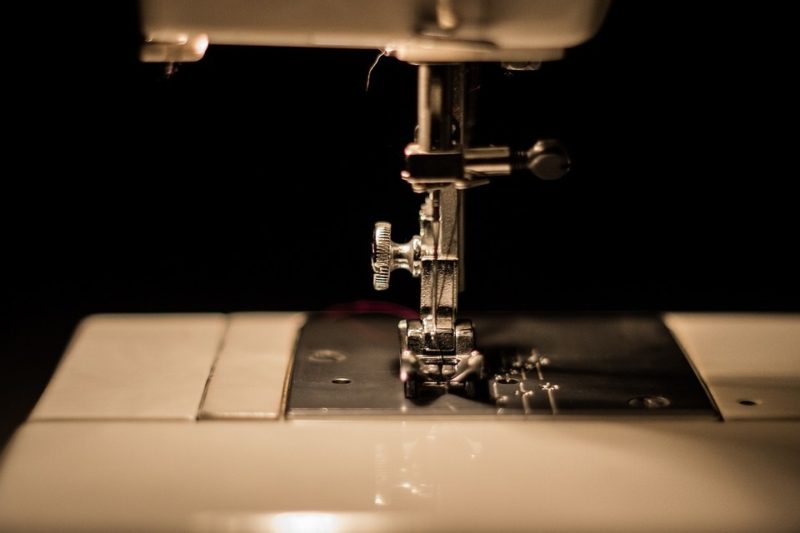You can learn how does a sewing machine make a stitch by reading about the two-thread mechanism and how the fabric moves. We will also discuss what stitches sewing machines are capable of to help you further appreciate this device invented way back in 1790.
But for additional information about the general working powerhouse of the machine, please read how does a sewing machine works? That separate article discusses each part of the machine to help you understand the discussion below.

How Does A Sewing Machine Make A Stitch Quickly And Perfectly
How stitches are made
A sewing machine makes stitches from the needle thread and bobbin thread compared to hand stitching that relies on a threaded needle alone that you’ll push in and out the fabric. With a sewing machine, the needle is only there to create an opening for the fabric with one thread.
And once the needle thread is through the fabric, it will form a knot with the bobbin thread before the machine pulls it back up again. So compared to stitching by hand that relies on just the needle, the knot creates the stitches with a sewing machine.
Are you still having trouble imagining the stitching mechanism of the sewing machine? Read how it works step by step:
- The threaded needle pierces the fabric and needle plate, and the thread against the needle plate creates a loop
- A rotating hook catches the said loop and have it encircle the bobbin case
- The bobbin or lower thread will be caught in the needle thread loop to form a knot
- The needle pulls the needle thread back up to tighten the knot to the fabric, and the stitch is done
How the stitching and fabric moves at the same time
For successful sewing, the stitches should be synchronized with the movement of the fabric in the sewing machine. This is possible because as the two threads form the stitch, the feed dogs and presser foot will pull the fabric towards and between stitches.
Which Part Of The Sewing Machine Makes Stitches?
The forming knot between the upper and lower thread forms the stitches, but the thread take-up lever of the sewing machine is responsible for controlling the thread since it raises and lowers it as the machine makes stitches. Additionally, one can say that the sewing machine motor influences the stitching cycle.
This is why you will find that the sewing speed or stitches per second is always mentioned on sewing machine specifications when buying one. The sewing machine motor will also give you an idea of how the needle can effectively sew through the fabric quickly without breaking or leaving skipped stitches.
What Stitch Does A Sewing Machine Use?
Depending on the sewing machine model you have, your unit may be capable of various stitch types not limited to the basic ones like straight and zigzag stitches.
Straight stitch
- Most common stitch in the sewing machine
- Versatile for most sewing projects
- Some machines allow adjustable length for the straight stitch with 2.0 to 3.0 for most projects, 4.0 for gathering and basting
- Some machines have a straight stretch stitch for working with stretchy fabrics
Zigzag stitch
- Another common and versatile sewing machine stitch beside the straight stitch
- Useful for finishing fabric edges to prevent fraying
- Allows some elasticity, useful for knits and some stretch materials
- Can be set as a narrow zigzag stitch for knits, finishing hems, and reinforcing areas prone to stress
- For fabric gathering
- As an alternative for other applique stitches
- Some machines have a three-step zigzag stitch
Overedge stitch
- Finishing raw edges, hems, and seams if you don’t have a serger
- Overlocking edges for a more professional-looking finish
- Creates strong seams
- Ideal for sewing garments and projects prone to wear and tear
Do you want to learn how to do an overcast stitch on a sewing machine? Read our tutorial that is helpful for beginners.
What Is A Straight Stitch Sewing Machine?
A straight stitch sewing machine is the most basic type of sewing machine. From the name itself, this sewing machine type is only capable of straight stitching.
An example of a straight stitch sewing machine is the treadle sewing machine. Unlike modern units, a treadle can only sew a single straight stitch, and you can learn more about what is a treadle sewing machine in our separate article.
What Stitch Is Used For Seams?
The most common stitch for finishing and reinforcing seams is the zigzag stitch. It is even a common alternative for people who don’t own a serger.
However, contrary to popular belief, it’s possible to use the straight stitch for seams. Of course, the result is not as professional-looking or overedge or zigzag stitches, but you can always experiment with the tension, stitch length, and width.
Conclusion
Did you learn a lot from this article? To recap the discussion on how does a sewing machine make a stitch, we found out that the stitch is made from the knot formed by the needle and bobbin thread.
Compared to sewing by hand, where a single-threaded needle makes a stitch, the sewing machine has a second or lower thread crucial for creating a stitch. We also learned that the thread take-up lever is somewhat responsible for stitching since it raises and lowers the thread.
We hope this was helpful; leave us a question if you have any.
